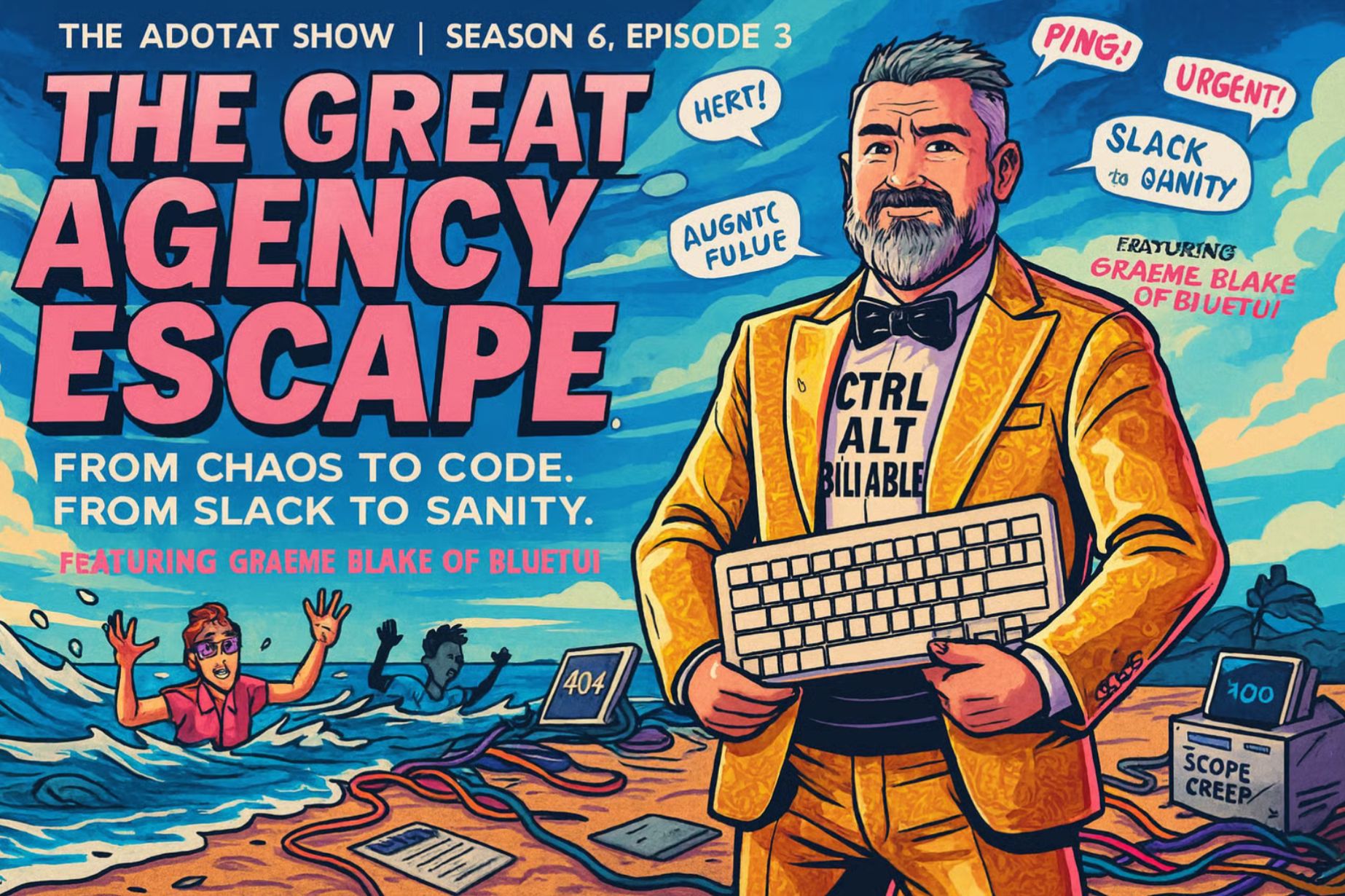October 24, 2025
From Chaos to Code: The Indie Agency Exodus
The Adotat Show : Session 1

Find the original ADOTAT post here:
There’s a specific kind of madness that runs through indie agencies, the kind you can smell on the stale coffee and half-baked briefs littering a WeWork desk. It’s the chaos of Slack threads that read like crime scene transcripts, and the spiritual hangover that comes from explaining to a client why “making a banner ad go viral” is not a growth strategy but a cry for help.
That’s where Graeme Blake began his journey, neck-deep in the creative trenches, surrounded by jargon, timelines, and clients who wanted champagne on a beer budget. I told him, half in jest, half in diagnosis: “So what possessed you to leap from selling ideas to building infrastructure for the idea sellers?”
Graeme’s reply came with the wry exhaustion of a man who has stared into the abyss of client revisions and decided to code his way out. “Clients kind of drove me to want to get out of advertising,” he said. You could almost hear the PTSD in his tone, the kind only creatives get after one too many rounds of “just a few minor changes.”
From Pain to Platform
Like most great revolutions, Blutui started not with vision boards or funding rounds, but with pure, unfiltered frustration. Graeme and his team hit the point every agency eventually reaches, where the chaos outweighs the creativity, and you start fantasizing about running away to join a SaaS startup.
So they did.
They took the pain, packaged it, and shipped it as a product. “We experienced a lot of pain in our own agency and figured we’d fix that pain point,” he said. And because misery loves company, they canvassed agencies around the world, asking if they too were drowning in miscommunication, outdated tech, and bad client math. Spoiler: everyone said yes.
That’s the origin of Blutui, the therapy session that became a software company. Think of it as agency PTSD meets API therapy. Instead of another overpriced tool built by people who’ve never met a client, Blutui came from the inside, a platform born in the war room, not the boardroom.
Graeme built it for the overworked, underpaid creative class that’s too busy “circling back” to notice they’re bleeding profit.
The Episode You Didn’t Know You Needed
This isn’t just another story about “disruption” or “AI-powered transformation.” This episode of The ADOTAT Show is about redemption, the moment you stop being the product and start building it.
We’re diving deep into why agencies are sitting on a gold mine of digital product revenue, and why most of them are too busy chasing trends to dig it up. In our conversation, Graeme lays out the unspoken truth every agency CEO should tattoo on their forearm: “There is margin in digital, they’re just too afraid to look for it.”
Over the next sections, we’re unpacking how fear, stubbornness, and legacy thinking turned the creative industry into a museum of missed opportunities.
In Part II, we’ll follow the money, how agencies accidentally outsourced their profits, and why Method in Motion in Singapore figured out how to stop bleeding cash using Blutui’s model.
In Part III, we’ll dig into what Graeme calls the “fear and loathing of digital builds,” where holding companies burn millions on tech platforms no one uses, and innovation dies in a Jira ticket.
In Part IV, we’ll eviscerate the myth of the “creative maverick”, the Don Draper archetype that’s kept the industry allergic to change while TikTok rewrote the rules of persuasion.
Part V is all about the money, the delusion of hourly billing, the death of retainers, and why so many agencies treat margin like an embarrassing rash.
 The Briefs, the Burnout, and the Banner Ad That Wouldn’t Die
The Briefs, the Burnout, and the Banner Ad That Wouldn’t Die
The Redemption of the Burned-Out Creative
Blutui isn’t just another tool in the stack. It’s what happens when an agency survivor decides to turn trauma into architecture. A platform built for creatives by someone who’s actually read their Slack DMs and lived to tell the tale.
What Graeme’s done isn’t sexy in the Cannes sense. There are no yachts, no NFTs, no “agentic activations.” But there’s something infinitely rarer: a business model that actually respects creativity.
So, yes, this episode is about code. But it’s also about catharsis. About taking the industry’s worst habits, the Slack chaos, the tech phobia, the fear of change, and turning them into a playbook for survival.
As I told Graeme at the end of our chat: he didn’t just build a platform; he built a lifeboat. And if you’re still on the sinking ship of “billable hours,” you might want to grab an oar.
Because in the next part, we’re going to talk about the one thing every agency has but refuses to admit, the untapped gold mine beneath the briefs.





